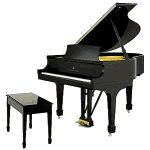

Composers from Amazon.com's Get Started in Classical:
| Bach | Glass | Schubert |
| Beethoven | Mahler | Stravinsky |
| Copland | Mozart | Tilson Thomas |
| Corigliano | Mutter | Wagner |
| Debussy | Pärt | Zimerman |
| NEW! Huang Additional composers and musicians |
||
Claude Debussy
This is from Amazon.com's Get Started in Classical.
Claude Debussy's music helped sow the seeds of modernism
The birth pangs of musical modernism produced a number of dramatically charged episodes that quickly became legends in their own right. Riots breaking out at the premieres of new works by Stravinsky and Schönberg (now treasured as classics) have come to symbolize the embattled stance of composer against hostile audience that is wrapped up in the mythology of 20th-century music.
But that's not the whole story. The art of Claude Debussy (1862-1918) illustrates a profoundly radical rethinking of the language and content of music. Debussy's new approach to music's basic elements--rhythmic pulse, harmonic progression, orchestral coloring, and tonality itself--makes him one of the key points of origin for the whole panoply of modernist innovation, and his influence on later composers would be widespread. Yet Debussy accomplished all this, by and large, without alienating the audiences of his time. To be sure, his free thinking offended academic caretakers of tradition, and critics continually lashed out ("orgies of modulation" was the typical sort of complaint). Nevertheless, one of his first truly revolutionary works, Prelude to the Afternoon of a Faun, found initial success with the public, while Pelléas et Mélisande--Debussy's operatic masterpiece--managed to sell out some of its first performances. Rather than a Big Bang theory of the origin of modern music, Debussy represents something far subtler.
With this recording of orchestral works played by the Los Angeles Philharmonic under Esa-Pekka Salonen, you'll find yourself on the threshold of a musical paradigm shift; what may perhaps come as a surprise is the seductive beauty of such pathbreaking art. The newness of Debussy's music lies in its particular vocabulary and in its sense of how to develop that vocabulary into larger structures. Inspired by such diverse sources as Russian music, the maverick French composer Erik Satie, and Javanese gamelan, Debussy rebelled against the German romantic rhetoric that had gained dominance by the late 19th century (above all Wagner), finding it to be a dead end.
Play a whole-tone scale--one using only whole-tone intervals, rather than the pattern of mixed whole and half steps of the traditional major and minor scales--and you have one of the staples of this composer's toolkit. Debussy uses this, together with archaic modes, unconventional and shifting harmonies, and delicately refined tonal colors, to construct his elusive, indeterminate sound world. The result is a deliciously mesmerizing vagueness that has caused Debussy to be seen as the musical equivalent of his contemporary painter associates, the Impressionists. With the Prelude to the Afternoon of a Faun, he leaves behind the romantic world of emotional declaration and enters a nebulous, twilit sphere that resounds with ambiguity. The Siren-like flute solo that opens the piece is every bit as revolutionary as the high-pitched bassoon that starts off Stravinsky's Rite of Spring two decades later.
The analogy to Impressionism has its aptness, but don't limit yourself to it. Certainly there's a painterly quality to the way Debussy mixes and applies orchestral colors (notice the magical touch of the "antique cymbal" chiming in at the final reprise of that flute theme, for example). Yet the composer himself, much like many of the so-called minimalists in our time, objected to being pigeonholed by a label. Moreover, Debussy was tremendously sensitive to literary influences as well as visual stimuli--in fact, Prelude was inspired by a poem of the Symbolist Stéphane Mallarmé about a faun's erotic dream of a nymph. Calling to mind Charles Baudelaire's "correspondences," Debussy abandons conventional thematic development in favor of a structure that is closer to the hazy logic of dreams, marvelously suggesting the liminal state between sleeping and consciousness.
There's a fascinating tension in Debussy's music between its seeming looseness and its demand for precise detail, its moments of stasis and constantly shifting atmospheres--all of which comes to the fore in La Mer, considered by many his orchestral masterpiece. That poses a real challenge for interpreters, but Esa-Pekka Salonen leads a performance here that powerfully captures both the piece's transparency and its frightening energy. In attempting to render the ambiguities of the sea--its flickering play of light, awesome beauty, and death-holding menace--Debussy found an ideal mirror for the ambiguities of his own art.
Thomas May, Classical Editor
More Debussy can be found in Musical Information and Recommendations for Adults.
O'Connor Music Studio Recommendations
lists Books, CD's, Cassette Tapes, Computer Programs, Music Scores DVD's, Videos and more
from amazon.com, as well as several other sources.
 If you are looking for ideas for children's books, cd's, cassette tapes, computer
programs, games and toys, click here for some ideas.
If you are looking for ideas for children's books, cd's, cassette tapes, computer
programs, games and toys, click here for some ideas.
Many thanks to Dearest for everything!
is located
in Fairfax, Virginia
Over 30 Years
~~
Piano, Organ
Electric Keyboard
Accompanying
Email Mary O'Connor
All rights reserved.
Site design and maintenance by
O'Connor O'Riginals Web Design